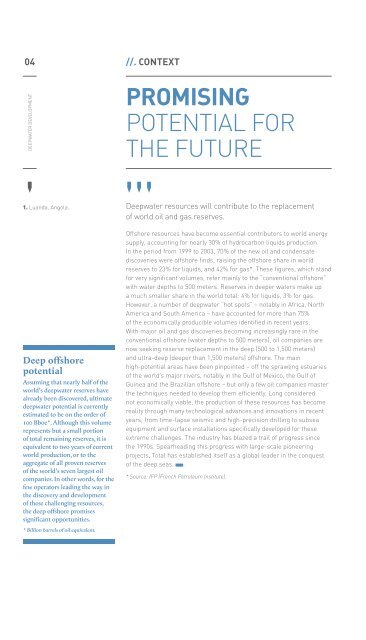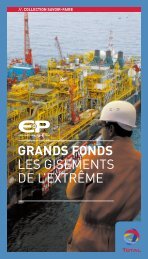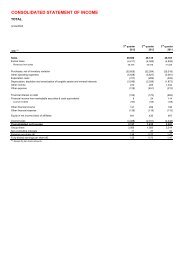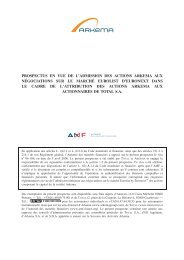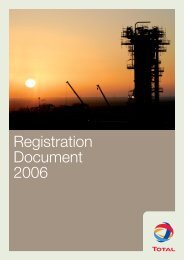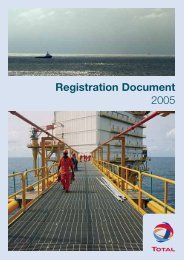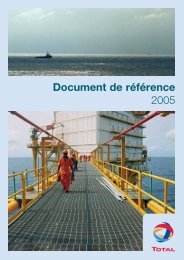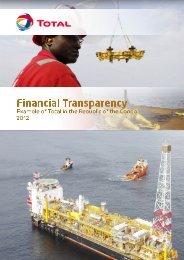Deepwater development The ultimate frontier - Total.com
Deepwater development The ultimate frontier - Total.com
Deepwater development The ultimate frontier - Total.com
Create successful ePaper yourself
Turn your PDF publications into a flip-book with our unique Google optimized e-Paper software.
04<br />
DeePWaTer DeVeloPmenT<br />
s<br />
1. luanda, angola.<br />
Deep offshore<br />
potential<br />
Assuming that nearly half of the<br />
world’s deepwater reserves have<br />
already been discovered, <strong>ultimate</strong><br />
deepwater potential is currently<br />
estimated to be on the order of<br />
100 Bboe*. Although this volume<br />
represents but a small portion<br />
of total remaining reserves, it is<br />
equivalent to two years of current<br />
world production, or to the<br />
aggregate of all proven reserves<br />
of the world’s seven largest oil<br />
<strong>com</strong>panies. In other words, for the<br />
few operators leading the way in<br />
the discovery and <strong>development</strong><br />
of these challenging resources,<br />
the deep offshore promises<br />
significant opportunities.<br />
* Billion barrels of oil equivalent.<br />
//. CONtext<br />
PrOMisiNG<br />
PoTenTial for<br />
<strong>The</strong> fuTure<br />
s s s<br />
<strong>Deepwater</strong> resources will contribute to the replacement<br />
of world oil and gas reserves.<br />
offshore resources have be<strong>com</strong>e essential contributors to world energy<br />
supply, accounting for nearly 30% of hydrocarbon liquids production.<br />
in the period from 1999 to 2003, 70% of the new oil and condensate<br />
discoveries were offshore finds, raising the offshore share in world<br />
reserves to 23% for liquids, and 42% for gas*. <strong>The</strong>se figures, which stand<br />
for very significant volumes, refer mainly to the “conventional offshore”<br />
with water depths to 500 meters. reserves in deeper waters make up<br />
a much smaller share in the world total: 4% for liquids, 3% for gas.<br />
however, a number of deepwater “hot spots” – notably in africa, north<br />
america and South america – have accounted for more than 75%<br />
of the economically producible volumes identified in recent years.<br />
With major oil and gas discoveries be<strong>com</strong>ing increasingly rare in the<br />
conventional offshore (water depths to 500 meters), oil <strong>com</strong>panies are<br />
now seeking reserve replacement in the deep (500 to 1,500 meters)<br />
and ultra-deep (deeper than 1,500 meters) offshore. <strong>The</strong> main<br />
high-potential areas have been pinpointed – off the sprawling estuaries<br />
of the world’s major rivers, notably in the Gulf of mexico, the Gulf of<br />
Guinea and the Brazilian offshore – but only a few oil <strong>com</strong>panies master<br />
the techniques needed to develop them efficiently. long considered<br />
not economically viable, the production of these resources has be<strong>com</strong>e<br />
reality through many technological advances and innovations in recent<br />
years, from time-lapse seismic and high-precision drilling to subsea<br />
equipment and surface installations specifically developed for these<br />
extreme challenges. <strong>The</strong> industry has blazed a trail of progress since<br />
the 1990s. Spearheading this progress with large-scale pioneering<br />
projects, <strong>Total</strong> has established itself as a global leader in the conquest<br />
of the deep seas. nnn<br />
* Source: IFP (French Petroleum Institute).


